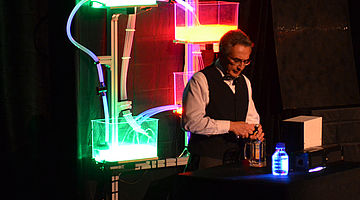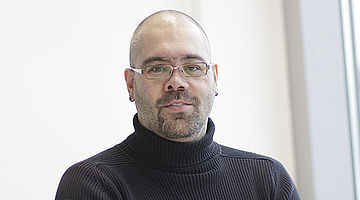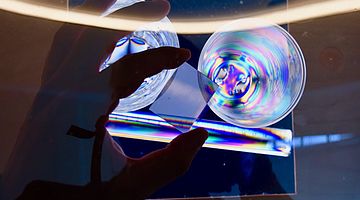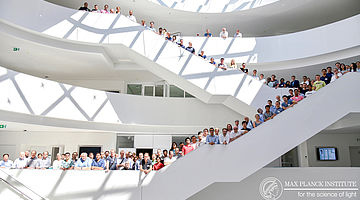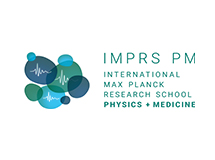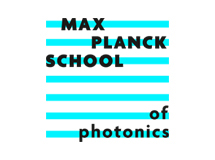- Home
- News & Events
- News from the Institute
Light and sound waves reveal negative pressure
Negative pressure is a rare and challenging-to-detect phenomenon in physics. Using liquid-filled optical fibers and sound waves, researchers at the Max Planck Institute for the Science of Light (MPL) in Erlangen have now discovered a new method to measure it. In collaboration with the Leibniz Institute of Photonic Technologies in Jena (IPHT), the scientists in the Quantum Optoacoustics research group, led by Birgit Stiller, can gain important insights into thermodynamic states.
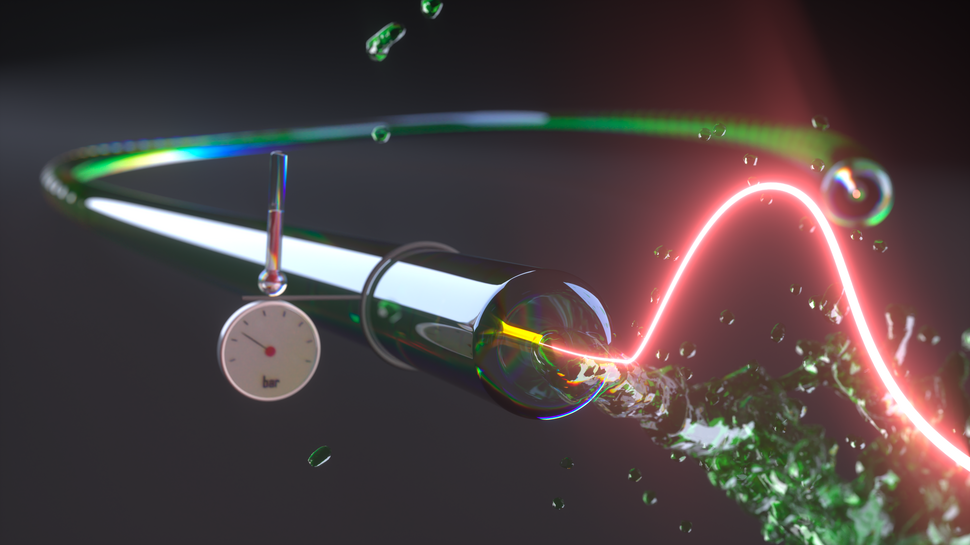
As a physical quantity pressure is encountered in various fields: atmospheric pressure in meteorology, blood pressure in medicine, or even in everyday life with pressure cookers and vacuum-sealed foods. Pressure is defined as a force per unit area acting perpendicular to a surface of a solid, liquid, or gas. Depending on the direction in which the force acts within a closed system, very high pressure can lead to explosive reactions in extrem cases, while very low pressure in a closed system can cause the implosion of the system itself. Overpressure always means that the gas or liquid pushes against the walls of its container from the inside, like a balloon expanding when more air is added. Regardless of whether it's high or low pressure, the numerical value of pressure is always positive under normal circumstances.
However, liquids exhibit a peculiar characteristic. They can exist in a specific metastable state corresponding to a negative pressure value. In this metastable state, even a tiny external influence can cause the system to collapse into one state or another. One can imagine it as sitting at the top of a roller coaster: the slightest touch on one side or the other sends you hurtling down the tracks. In their current research, the scientists are examining the metastable state of liquids with negative pressure. To achieve this, the research team combined two unique techniques in a study published in Nature Physics to measure various thermodynamic states. Initially, tiny amounts - nanoliters - of a liquid were encapsulated in a fully closed optical fiber, allowing both highly positive and negative pressures. Subsequently, the specific interaction of optical and acoustic waves in the liquid enabled the sensitive measurement of the influence of pressure and temperature in different states of the liquid. Sound waves act as sensors for examining negative pressure values, exploring this unique state of matter with high precision and detailed spatial resolution.

The influence of negative pressure on a liquid can be envisioned as follows: According to the laws of thermodynamics, the volume of the liquid will decrease, but the liquid is retained in the glass fiber capillary by adhesive forces, much like a water droplet sticking to a finger. This results in a "stretching" of the liquid. It is pulled apart and behaves like a rubber band being stretched. Measuring this exotic state typically requires complex equipment with heightened safety precautions. High pressures can be hazardous endeavors, particularly with toxic liquids. Carbon disulfide, used by the researchers in this study, falls into this category. Due to this complication, previous measurement setups for generating and determining negative pressures have required significant laboratory space and even posed a disturbance to the system in the metastable state. With the method presented here, the researchers have instead developed a tiny, simple setup in which they can make very precise pressure measurements using light and sound waves. The fiber used for this purpose is only as thick as a human hair.
"Some phenomena which are difficult to explore with ordinary and established methods can become unexpectedly accessible when new measurement methods are combined with novel platforms. I find that exciting," says Dr. Birgit Stiller, head of the Quantum Optoacoustics research group at MPL. The sound waves used by the group can detect temperature, pressure, and strain changes very sensitively along an optical fiber. Furthermore, spatially resolved measurements are possible, meaning that the sound waves can provide an image of the situation inside the optical fiber at centimeter-scale resolution along its length. "Our method allows us to gain a deeper understanding of the thermodynamic dependencies in this unique fiber-based system," says Alexandra Popp, one of the two lead authors of the article. The other lead author, Andreas Geilen, adds: "The measurements revealed some surprising effects. The observation of the negative pressure regime becomes abundantly clear when looking at the frequency of the sound waves."

The combination of optoacoustic measurements with tightly sealed capillary fibers enables new discoveries regarding the monitoring of chemical reactions in toxic liquids within otherwise difficult-to-investigate materials and microreactors. It can penetrate new, hard-to-access areas of thermodynamics. "This new platform of fully sealed liquid core fibers provides access to high pressures and other thermodynamic regimes," says Prof. Markus Schmidt from IPHT in Jena, and Dr. Mario Chemnitz, also from IPHT in Jena, emphasizes: "It is of great interest to investigate and even tailor further nonlinear optical phenomena in this type of fiber." These phenomena can unlock previously unexplored and potentially new properties in the unique thermodynamic state of materials. Birgit Stiller concludes: "The collaboration between our research groups in Erlangen and Jena, with their respective expertise, is unique in gaining new insights into thermodynamic processes and regimes on a tiny and easy-to-handle optical platform."
Original publication in Nature Physics: Geilen, A., Popp, A., Das, D. et al. "Extreme thermodynamics in nanolitre volumes through stimulated Brillouin–Mandelstam scattering"
DOI: 10.1038/s41567-023-02205-1
Contact:
Dr. Birgit Stiller
Research group leader ›Quantum Optoacoustics‹ at the Max Planck Institute for the Science of Light, Erlangen.
www.mpl.mpg.de / birgit.stiller@mpl.mpg.de
Image 1 (© Long Huy Dao): Artist’s impression of a liquid-filled glass capillary.
Image 2 (© Florian Ritter, MPL): (From left to right) Research group leader Birgit Stiller in the lab with Andreas Geilen and Alexandra Popp.
Image 3 (© Stephan Spangenberg): Research group leader Birgit Stiller in the lab.
Light and sound waves reveal negative pressure
Negative pressure is a rare and challenging-to-detect phenomenon in physics. Using liquid-filled optical fibers and sound waves, researchers at the Max Planck Institute for the Science of Light (MPL) in Erlangen have now discovered a new method to measure it. In collaboration with the Leibniz Institute of Photonic Technologies in Jena (IPHT), the scientists in the Quantum Optoacoustics research group, led by Birgit Stiller, can gain important insights into thermodynamic states.

As a physical quantity pressure is encountered in various fields: atmospheric pressure in meteorology, blood pressure in medicine, or even in everyday life with pressure cookers and vacuum-sealed foods. Pressure is defined as a force per unit area acting perpendicular to a surface of a solid, liquid, or gas. Depending on the direction in which the force acts within a closed system, very high pressure can lead to explosive reactions in extrem cases, while very low pressure in a closed system can cause the implosion of the system itself. Overpressure always means that the gas or liquid pushes against the walls of its container from the inside, like a balloon expanding when more air is added. Regardless of whether it's high or low pressure, the numerical value of pressure is always positive under normal circumstances.
However, liquids exhibit a peculiar characteristic. They can exist in a specific metastable state corresponding to a negative pressure value. In this metastable state, even a tiny external influence can cause the system to collapse into one state or another. One can imagine it as sitting at the top of a roller coaster: the slightest touch on one side or the other sends you hurtling down the tracks. In their current research, the scientists are examining the metastable state of liquids with negative pressure. To achieve this, the research team combined two unique techniques in a study published in Nature Physics to measure various thermodynamic states. Initially, tiny amounts - nanoliters - of a liquid were encapsulated in a fully closed optical fiber, allowing both highly positive and negative pressures. Subsequently, the specific interaction of optical and acoustic waves in the liquid enabled the sensitive measurement of the influence of pressure and temperature in different states of the liquid. Sound waves act as sensors for examining negative pressure values, exploring this unique state of matter with high precision and detailed spatial resolution.

The influence of negative pressure on a liquid can be envisioned as follows: According to the laws of thermodynamics, the volume of the liquid will decrease, but the liquid is retained in the glass fiber capillary by adhesive forces, much like a water droplet sticking to a finger. This results in a "stretching" of the liquid. It is pulled apart and behaves like a rubber band being stretched. Measuring this exotic state typically requires complex equipment with heightened safety precautions. High pressures can be hazardous endeavors, particularly with toxic liquids. Carbon disulfide, used by the researchers in this study, falls into this category. Due to this complication, previous measurement setups for generating and determining negative pressures have required significant laboratory space and even posed a disturbance to the system in the metastable state. With the method presented here, the researchers have instead developed a tiny, simple setup in which they can make very precise pressure measurements using light and sound waves. The fiber used for this purpose is only as thick as a human hair.
"Some phenomena which are difficult to explore with ordinary and established methods can become unexpectedly accessible when new measurement methods are combined with novel platforms. I find that exciting," says Dr. Birgit Stiller, head of the Quantum Optoacoustics research group at MPL. The sound waves used by the group can detect temperature, pressure, and strain changes very sensitively along an optical fiber. Furthermore, spatially resolved measurements are possible, meaning that the sound waves can provide an image of the situation inside the optical fiber at centimeter-scale resolution along its length. "Our method allows us to gain a deeper understanding of the thermodynamic dependencies in this unique fiber-based system," says Alexandra Popp, one of the two lead authors of the article. The other lead author, Andreas Geilen, adds: "The measurements revealed some surprising effects. The observation of the negative pressure regime becomes abundantly clear when looking at the frequency of the sound waves."

The combination of optoacoustic measurements with tightly sealed capillary fibers enables new discoveries regarding the monitoring of chemical reactions in toxic liquids within otherwise difficult-to-investigate materials and microreactors. It can penetrate new, hard-to-access areas of thermodynamics. "This new platform of fully sealed liquid core fibers provides access to high pressures and other thermodynamic regimes," says Prof. Markus Schmidt from IPHT in Jena, and Dr. Mario Chemnitz, also from IPHT in Jena, emphasizes: "It is of great interest to investigate and even tailor further nonlinear optical phenomena in this type of fiber." These phenomena can unlock previously unexplored and potentially new properties in the unique thermodynamic state of materials. Birgit Stiller concludes: "The collaboration between our research groups in Erlangen and Jena, with their respective expertise, is unique in gaining new insights into thermodynamic processes and regimes on a tiny and easy-to-handle optical platform."
Original publication in Nature Physics: Geilen, A., Popp, A., Das, D. et al. "Extreme thermodynamics in nanolitre volumes through stimulated Brillouin–Mandelstam scattering"
DOI: 10.1038/s41567-023-02205-1
Contact:
Dr. Birgit Stiller
Research group leader ›Quantum Optoacoustics‹ at the Max Planck Institute for the Science of Light, Erlangen.
www.mpl.mpg.de / birgit.stiller@mpl.mpg.de
Image 1 (© Long Huy Dao): Artist’s impression of a liquid-filled glass capillary.
Image 2 (© Florian Ritter, MPL): (From left to right) Research group leader Birgit Stiller in the lab with Andreas Geilen and Alexandra Popp.
Image 3 (© Stephan Spangenberg): Research group leader Birgit Stiller in the lab.
Light and sound waves reveal negative pressure
Negative pressure is a rare and challenging-to-detect phenomenon in physics. Using liquid-filled optical fibers and sound waves, researchers at the Max Planck Institute for the Science of Light (MPL) in Erlangen have now discovered a new method to measure it. In collaboration with the Leibniz Institute of Photonic Technologies in Jena (IPHT), the scientists in the Quantum Optoacoustics research group, led by Birgit Stiller, can gain important insights into thermodynamic states.

As a physical quantity pressure is encountered in various fields: atmospheric pressure in meteorology, blood pressure in medicine, or even in everyday life with pressure cookers and vacuum-sealed foods. Pressure is defined as a force per unit area acting perpendicular to a surface of a solid, liquid, or gas. Depending on the direction in which the force acts within a closed system, very high pressure can lead to explosive reactions in extrem cases, while very low pressure in a closed system can cause the implosion of the system itself. Overpressure always means that the gas or liquid pushes against the walls of its container from the inside, like a balloon expanding when more air is added. Regardless of whether it's high or low pressure, the numerical value of pressure is always positive under normal circumstances.
However, liquids exhibit a peculiar characteristic. They can exist in a specific metastable state corresponding to a negative pressure value. In this metastable state, even a tiny external influence can cause the system to collapse into one state or another. One can imagine it as sitting at the top of a roller coaster: the slightest touch on one side or the other sends you hurtling down the tracks. In their current research, the scientists are examining the metastable state of liquids with negative pressure. To achieve this, the research team combined two unique techniques in a study published in Nature Physics to measure various thermodynamic states. Initially, tiny amounts - nanoliters - of a liquid were encapsulated in a fully closed optical fiber, allowing both highly positive and negative pressures. Subsequently, the specific interaction of optical and acoustic waves in the liquid enabled the sensitive measurement of the influence of pressure and temperature in different states of the liquid. Sound waves act as sensors for examining negative pressure values, exploring this unique state of matter with high precision and detailed spatial resolution.

The influence of negative pressure on a liquid can be envisioned as follows: According to the laws of thermodynamics, the volume of the liquid will decrease, but the liquid is retained in the glass fiber capillary by adhesive forces, much like a water droplet sticking to a finger. This results in a "stretching" of the liquid. It is pulled apart and behaves like a rubber band being stretched. Measuring this exotic state typically requires complex equipment with heightened safety precautions. High pressures can be hazardous endeavors, particularly with toxic liquids. Carbon disulfide, used by the researchers in this study, falls into this category. Due to this complication, previous measurement setups for generating and determining negative pressures have required significant laboratory space and even posed a disturbance to the system in the metastable state. With the method presented here, the researchers have instead developed a tiny, simple setup in which they can make very precise pressure measurements using light and sound waves. The fiber used for this purpose is only as thick as a human hair.
"Some phenomena which are difficult to explore with ordinary and established methods can become unexpectedly accessible when new measurement methods are combined with novel platforms. I find that exciting," says Dr. Birgit Stiller, head of the Quantum Optoacoustics research group at MPL. The sound waves used by the group can detect temperature, pressure, and strain changes very sensitively along an optical fiber. Furthermore, spatially resolved measurements are possible, meaning that the sound waves can provide an image of the situation inside the optical fiber at centimeter-scale resolution along its length. "Our method allows us to gain a deeper understanding of the thermodynamic dependencies in this unique fiber-based system," says Alexandra Popp, one of the two lead authors of the article. The other lead author, Andreas Geilen, adds: "The measurements revealed some surprising effects. The observation of the negative pressure regime becomes abundantly clear when looking at the frequency of the sound waves."

The combination of optoacoustic measurements with tightly sealed capillary fibers enables new discoveries regarding the monitoring of chemical reactions in toxic liquids within otherwise difficult-to-investigate materials and microreactors. It can penetrate new, hard-to-access areas of thermodynamics. "This new platform of fully sealed liquid core fibers provides access to high pressures and other thermodynamic regimes," says Prof. Markus Schmidt from IPHT in Jena, and Dr. Mario Chemnitz, also from IPHT in Jena, emphasizes: "It is of great interest to investigate and even tailor further nonlinear optical phenomena in this type of fiber." These phenomena can unlock previously unexplored and potentially new properties in the unique thermodynamic state of materials. Birgit Stiller concludes: "The collaboration between our research groups in Erlangen and Jena, with their respective expertise, is unique in gaining new insights into thermodynamic processes and regimes on a tiny and easy-to-handle optical platform."
Original publication in Nature Physics: Geilen, A., Popp, A., Das, D. et al. "Extreme thermodynamics in nanolitre volumes through stimulated Brillouin–Mandelstam scattering"
DOI: 10.1038/s41567-023-02205-1
Contact:
Dr. Birgit Stiller
Research group leader ›Quantum Optoacoustics‹ at the Max Planck Institute for the Science of Light, Erlangen.
www.mpl.mpg.de / birgit.stiller@mpl.mpg.de
Image 1 (© Long Huy Dao): Artist’s impression of a liquid-filled glass capillary.
Image 2 (© Florian Ritter, MPL): (From left to right) Research group leader Birgit Stiller in the lab with Andreas Geilen and Alexandra Popp.
Image 3 (© Stephan Spangenberg): Research group leader Birgit Stiller in the lab.
Light and sound waves reveal negative pressure
Negative pressure is a rare and challenging-to-detect phenomenon in physics. Using liquid-filled optical fibers and sound waves, researchers at the Max Planck Institute for the Science of Light (MPL) in Erlangen have now discovered a new method to measure it. In collaboration with the Leibniz Institute of Photonic Technologies in Jena (IPHT), the scientists in the Quantum Optoacoustics research group, led by Birgit Stiller, can gain important insights into thermodynamic states.

As a physical quantity pressure is encountered in various fields: atmospheric pressure in meteorology, blood pressure in medicine, or even in everyday life with pressure cookers and vacuum-sealed foods. Pressure is defined as a force per unit area acting perpendicular to a surface of a solid, liquid, or gas. Depending on the direction in which the force acts within a closed system, very high pressure can lead to explosive reactions in extrem cases, while very low pressure in a closed system can cause the implosion of the system itself. Overpressure always means that the gas or liquid pushes against the walls of its container from the inside, like a balloon expanding when more air is added. Regardless of whether it's high or low pressure, the numerical value of pressure is always positive under normal circumstances.
However, liquids exhibit a peculiar characteristic. They can exist in a specific metastable state corresponding to a negative pressure value. In this metastable state, even a tiny external influence can cause the system to collapse into one state or another. One can imagine it as sitting at the top of a roller coaster: the slightest touch on one side or the other sends you hurtling down the tracks. In their current research, the scientists are examining the metastable state of liquids with negative pressure. To achieve this, the research team combined two unique techniques in a study published in Nature Physics to measure various thermodynamic states. Initially, tiny amounts - nanoliters - of a liquid were encapsulated in a fully closed optical fiber, allowing both highly positive and negative pressures. Subsequently, the specific interaction of optical and acoustic waves in the liquid enabled the sensitive measurement of the influence of pressure and temperature in different states of the liquid. Sound waves act as sensors for examining negative pressure values, exploring this unique state of matter with high precision and detailed spatial resolution.

The influence of negative pressure on a liquid can be envisioned as follows: According to the laws of thermodynamics, the volume of the liquid will decrease, but the liquid is retained in the glass fiber capillary by adhesive forces, much like a water droplet sticking to a finger. This results in a "stretching" of the liquid. It is pulled apart and behaves like a rubber band being stretched. Measuring this exotic state typically requires complex equipment with heightened safety precautions. High pressures can be hazardous endeavors, particularly with toxic liquids. Carbon disulfide, used by the researchers in this study, falls into this category. Due to this complication, previous measurement setups for generating and determining negative pressures have required significant laboratory space and even posed a disturbance to the system in the metastable state. With the method presented here, the researchers have instead developed a tiny, simple setup in which they can make very precise pressure measurements using light and sound waves. The fiber used for this purpose is only as thick as a human hair.
"Some phenomena which are difficult to explore with ordinary and established methods can become unexpectedly accessible when new measurement methods are combined with novel platforms. I find that exciting," says Dr. Birgit Stiller, head of the Quantum Optoacoustics research group at MPL. The sound waves used by the group can detect temperature, pressure, and strain changes very sensitively along an optical fiber. Furthermore, spatially resolved measurements are possible, meaning that the sound waves can provide an image of the situation inside the optical fiber at centimeter-scale resolution along its length. "Our method allows us to gain a deeper understanding of the thermodynamic dependencies in this unique fiber-based system," says Alexandra Popp, one of the two lead authors of the article. The other lead author, Andreas Geilen, adds: "The measurements revealed some surprising effects. The observation of the negative pressure regime becomes abundantly clear when looking at the frequency of the sound waves."

The combination of optoacoustic measurements with tightly sealed capillary fibers enables new discoveries regarding the monitoring of chemical reactions in toxic liquids within otherwise difficult-to-investigate materials and microreactors. It can penetrate new, hard-to-access areas of thermodynamics. "This new platform of fully sealed liquid core fibers provides access to high pressures and other thermodynamic regimes," says Prof. Markus Schmidt from IPHT in Jena, and Dr. Mario Chemnitz, also from IPHT in Jena, emphasizes: "It is of great interest to investigate and even tailor further nonlinear optical phenomena in this type of fiber." These phenomena can unlock previously unexplored and potentially new properties in the unique thermodynamic state of materials. Birgit Stiller concludes: "The collaboration between our research groups in Erlangen and Jena, with their respective expertise, is unique in gaining new insights into thermodynamic processes and regimes on a tiny and easy-to-handle optical platform."
Original publication in Nature Physics: Geilen, A., Popp, A., Das, D. et al. "Extreme thermodynamics in nanolitre volumes through stimulated Brillouin–Mandelstam scattering"
DOI: 10.1038/s41567-023-02205-1
Contact:
Dr. Birgit Stiller
Research group leader ›Quantum Optoacoustics‹ at the Max Planck Institute for the Science of Light, Erlangen.
www.mpl.mpg.de / birgit.stiller@mpl.mpg.de
Image 1 (© Long Huy Dao): Artist’s impression of a liquid-filled glass capillary.
Image 2 (© Florian Ritter, MPL): (From left to right) Research group leader Birgit Stiller in the lab with Andreas Geilen and Alexandra Popp.
Image 3 (© Stephan Spangenberg): Research group leader Birgit Stiller in the lab.
Light and sound waves reveal negative pressure
Negative pressure is a rare and challenging-to-detect phenomenon in physics. Using liquid-filled optical fibers and sound waves, researchers at the Max Planck Institute for the Science of Light (MPL) in Erlangen have now discovered a new method to measure it. In collaboration with the Leibniz Institute of Photonic Technologies in Jena (IPHT), the scientists in the Quantum Optoacoustics research group, led by Birgit Stiller, can gain important insights into thermodynamic states.

As a physical quantity pressure is encountered in various fields: atmospheric pressure in meteorology, blood pressure in medicine, or even in everyday life with pressure cookers and vacuum-sealed foods. Pressure is defined as a force per unit area acting perpendicular to a surface of a solid, liquid, or gas. Depending on the direction in which the force acts within a closed system, very high pressure can lead to explosive reactions in extrem cases, while very low pressure in a closed system can cause the implosion of the system itself. Overpressure always means that the gas or liquid pushes against the walls of its container from the inside, like a balloon expanding when more air is added. Regardless of whether it's high or low pressure, the numerical value of pressure is always positive under normal circumstances.
However, liquids exhibit a peculiar characteristic. They can exist in a specific metastable state corresponding to a negative pressure value. In this metastable state, even a tiny external influence can cause the system to collapse into one state or another. One can imagine it as sitting at the top of a roller coaster: the slightest touch on one side or the other sends you hurtling down the tracks. In their current research, the scientists are examining the metastable state of liquids with negative pressure. To achieve this, the research team combined two unique techniques in a study published in Nature Physics to measure various thermodynamic states. Initially, tiny amounts - nanoliters - of a liquid were encapsulated in a fully closed optical fiber, allowing both highly positive and negative pressures. Subsequently, the specific interaction of optical and acoustic waves in the liquid enabled the sensitive measurement of the influence of pressure and temperature in different states of the liquid. Sound waves act as sensors for examining negative pressure values, exploring this unique state of matter with high precision and detailed spatial resolution.

The influence of negative pressure on a liquid can be envisioned as follows: According to the laws of thermodynamics, the volume of the liquid will decrease, but the liquid is retained in the glass fiber capillary by adhesive forces, much like a water droplet sticking to a finger. This results in a "stretching" of the liquid. It is pulled apart and behaves like a rubber band being stretched. Measuring this exotic state typically requires complex equipment with heightened safety precautions. High pressures can be hazardous endeavors, particularly with toxic liquids. Carbon disulfide, used by the researchers in this study, falls into this category. Due to this complication, previous measurement setups for generating and determining negative pressures have required significant laboratory space and even posed a disturbance to the system in the metastable state. With the method presented here, the researchers have instead developed a tiny, simple setup in which they can make very precise pressure measurements using light and sound waves. The fiber used for this purpose is only as thick as a human hair.
"Some phenomena which are difficult to explore with ordinary and established methods can become unexpectedly accessible when new measurement methods are combined with novel platforms. I find that exciting," says Dr. Birgit Stiller, head of the Quantum Optoacoustics research group at MPL. The sound waves used by the group can detect temperature, pressure, and strain changes very sensitively along an optical fiber. Furthermore, spatially resolved measurements are possible, meaning that the sound waves can provide an image of the situation inside the optical fiber at centimeter-scale resolution along its length. "Our method allows us to gain a deeper understanding of the thermodynamic dependencies in this unique fiber-based system," says Alexandra Popp, one of the two lead authors of the article. The other lead author, Andreas Geilen, adds: "The measurements revealed some surprising effects. The observation of the negative pressure regime becomes abundantly clear when looking at the frequency of the sound waves."

The combination of optoacoustic measurements with tightly sealed capillary fibers enables new discoveries regarding the monitoring of chemical reactions in toxic liquids within otherwise difficult-to-investigate materials and microreactors. It can penetrate new, hard-to-access areas of thermodynamics. "This new platform of fully sealed liquid core fibers provides access to high pressures and other thermodynamic regimes," says Prof. Markus Schmidt from IPHT in Jena, and Dr. Mario Chemnitz, also from IPHT in Jena, emphasizes: "It is of great interest to investigate and even tailor further nonlinear optical phenomena in this type of fiber." These phenomena can unlock previously unexplored and potentially new properties in the unique thermodynamic state of materials. Birgit Stiller concludes: "The collaboration between our research groups in Erlangen and Jena, with their respective expertise, is unique in gaining new insights into thermodynamic processes and regimes on a tiny and easy-to-handle optical platform."
Original publication in Nature Physics: Geilen, A., Popp, A., Das, D. et al. "Extreme thermodynamics in nanolitre volumes through stimulated Brillouin–Mandelstam scattering"
DOI: 10.1038/s41567-023-02205-1
Contact:
Dr. Birgit Stiller
Research group leader ›Quantum Optoacoustics‹ at the Max Planck Institute for the Science of Light, Erlangen.
www.mpl.mpg.de / birgit.stiller@mpl.mpg.de
Image 1 (© Long Huy Dao): Artist’s impression of a liquid-filled glass capillary.
Image 2 (© Florian Ritter, MPL): (From left to right) Research group leader Birgit Stiller in the lab with Andreas Geilen and Alexandra Popp.
Image 3 (© Stephan Spangenberg): Research group leader Birgit Stiller in the lab.
Light and sound waves reveal negative pressure
Negative pressure is a rare and challenging-to-detect phenomenon in physics. Using liquid-filled optical fibers and sound waves, researchers at the Max Planck Institute for the Science of Light (MPL) in Erlangen have now discovered a new method to measure it. In collaboration with the Leibniz Institute of Photonic Technologies in Jena (IPHT), the scientists in the Quantum Optoacoustics research group, led by Birgit Stiller, can gain important insights into thermodynamic states.

As a physical quantity pressure is encountered in various fields: atmospheric pressure in meteorology, blood pressure in medicine, or even in everyday life with pressure cookers and vacuum-sealed foods. Pressure is defined as a force per unit area acting perpendicular to a surface of a solid, liquid, or gas. Depending on the direction in which the force acts within a closed system, very high pressure can lead to explosive reactions in extrem cases, while very low pressure in a closed system can cause the implosion of the system itself. Overpressure always means that the gas or liquid pushes against the walls of its container from the inside, like a balloon expanding when more air is added. Regardless of whether it's high or low pressure, the numerical value of pressure is always positive under normal circumstances.
However, liquids exhibit a peculiar characteristic. They can exist in a specific metastable state corresponding to a negative pressure value. In this metastable state, even a tiny external influence can cause the system to collapse into one state or another. One can imagine it as sitting at the top of a roller coaster: the slightest touch on one side or the other sends you hurtling down the tracks. In their current research, the scientists are examining the metastable state of liquids with negative pressure. To achieve this, the research team combined two unique techniques in a study published in Nature Physics to measure various thermodynamic states. Initially, tiny amounts - nanoliters - of a liquid were encapsulated in a fully closed optical fiber, allowing both highly positive and negative pressures. Subsequently, the specific interaction of optical and acoustic waves in the liquid enabled the sensitive measurement of the influence of pressure and temperature in different states of the liquid. Sound waves act as sensors for examining negative pressure values, exploring this unique state of matter with high precision and detailed spatial resolution.

The influence of negative pressure on a liquid can be envisioned as follows: According to the laws of thermodynamics, the volume of the liquid will decrease, but the liquid is retained in the glass fiber capillary by adhesive forces, much like a water droplet sticking to a finger. This results in a "stretching" of the liquid. It is pulled apart and behaves like a rubber band being stretched. Measuring this exotic state typically requires complex equipment with heightened safety precautions. High pressures can be hazardous endeavors, particularly with toxic liquids. Carbon disulfide, used by the researchers in this study, falls into this category. Due to this complication, previous measurement setups for generating and determining negative pressures have required significant laboratory space and even posed a disturbance to the system in the metastable state. With the method presented here, the researchers have instead developed a tiny, simple setup in which they can make very precise pressure measurements using light and sound waves. The fiber used for this purpose is only as thick as a human hair.
"Some phenomena which are difficult to explore with ordinary and established methods can become unexpectedly accessible when new measurement methods are combined with novel platforms. I find that exciting," says Dr. Birgit Stiller, head of the Quantum Optoacoustics research group at MPL. The sound waves used by the group can detect temperature, pressure, and strain changes very sensitively along an optical fiber. Furthermore, spatially resolved measurements are possible, meaning that the sound waves can provide an image of the situation inside the optical fiber at centimeter-scale resolution along its length. "Our method allows us to gain a deeper understanding of the thermodynamic dependencies in this unique fiber-based system," says Alexandra Popp, one of the two lead authors of the article. The other lead author, Andreas Geilen, adds: "The measurements revealed some surprising effects. The observation of the negative pressure regime becomes abundantly clear when looking at the frequency of the sound waves."

The combination of optoacoustic measurements with tightly sealed capillary fibers enables new discoveries regarding the monitoring of chemical reactions in toxic liquids within otherwise difficult-to-investigate materials and microreactors. It can penetrate new, hard-to-access areas of thermodynamics. "This new platform of fully sealed liquid core fibers provides access to high pressures and other thermodynamic regimes," says Prof. Markus Schmidt from IPHT in Jena, and Dr. Mario Chemnitz, also from IPHT in Jena, emphasizes: "It is of great interest to investigate and even tailor further nonlinear optical phenomena in this type of fiber." These phenomena can unlock previously unexplored and potentially new properties in the unique thermodynamic state of materials. Birgit Stiller concludes: "The collaboration between our research groups in Erlangen and Jena, with their respective expertise, is unique in gaining new insights into thermodynamic processes and regimes on a tiny and easy-to-handle optical platform."
Original publication in Nature Physics: Geilen, A., Popp, A., Das, D. et al. "Extreme thermodynamics in nanolitre volumes through stimulated Brillouin–Mandelstam scattering"
DOI: 10.1038/s41567-023-02205-1
Contact:
Dr. Birgit Stiller
Research group leader ›Quantum Optoacoustics‹ at the Max Planck Institute for the Science of Light, Erlangen.
www.mpl.mpg.de / birgit.stiller@mpl.mpg.de
Image 1 (© Long Huy Dao): Artist’s impression of a liquid-filled glass capillary.
Image 2 (© Florian Ritter, MPL): (From left to right) Research group leader Birgit Stiller in the lab with Andreas Geilen and Alexandra Popp.
Image 3 (© Stephan Spangenberg): Research group leader Birgit Stiller in the lab.
December
Bavarian Maximiliansorden
Director Prof. Dr. Gerd Leuchs received the Bavarian Maximiliansorden for Science and Art. The award was officially presented on Monday, December 17th…
Let there be light
At the traditional christmas lecture of the Friedrich-Alexander-University (FAU) on December 13th, everything revolved around visible and invisible…
November
AAAS and MPL Announce 2018 Fellows
Prof. Dr. Gerd Leuchs has been named a Fellow of the American Association for the Advancement of Science (AAAS). Election as a AAAS Fellow is an honor…
Peter Hommelhoff becomes MPL Fellow
As of November 2018, Prof. Dr. Peter Hommelhoff, who holds the Chair of Laser Physics at the Friedrich-Alexander-University Erlangen-Nuremberg, will…
October
New MPL Research Group
We are happy to announce that as of October 2018, Kanwarpal Singh started his work at MPL as head of a new Research Group. Kanwarpal, who previously…
Jochen Guck becomes new director at MPL
As of Oktober 2018, Prof. Guck will lead the new MPL-Division "Physics & Medicine".
We would like to warmly welcome our new director Jochen Guck: As…
September
Laser Swords at Max Planck Day
On September 14th MPL, along with all other Max Planck Institutes, opened its doors to the general public. Some 700 visitors from Erlangen and the…
August
Herbert-Walther Award 2018
On March 7 2018, at a ceremony held during the Spring Meeting of the Deutsche Physikalische Gesellschaft (DPG), Gerd Leuchs received the 2018 Herbert…
Symposium for the Science of Light 2018
A Symposium for the Science of Light took place 23 to 26 July, in celebration of 150 years of optics in Erlangen, 15 years since the formation of the…
July
June
May
April
March
February
January
New Max Planck Research Group
As of January 2018, Silvia Viola Kusminskiy has taken up her position as the head of a new Max Planck Research Group (MPRG). Her group "Theory of…
Contact
Edda Fischer
Head of Communication and Marketing
Phone: +49 (0)9131 7133 805
MPLpresse@mpl.mpg.de
© Max Planck Institute for the Science of Light
Data Collection
This website uses cookies to ensure you get the best experience on our website.


